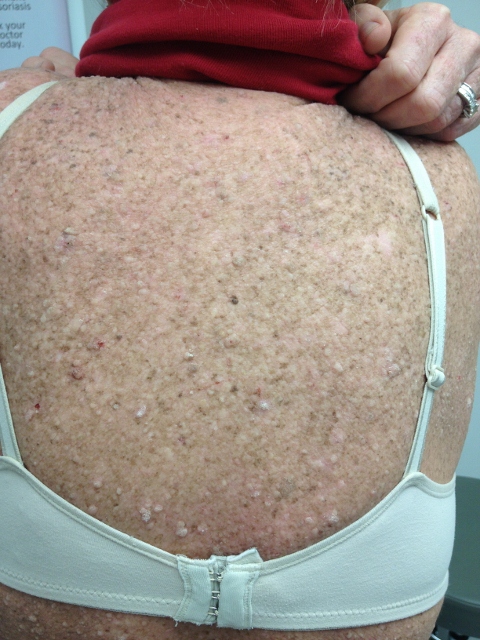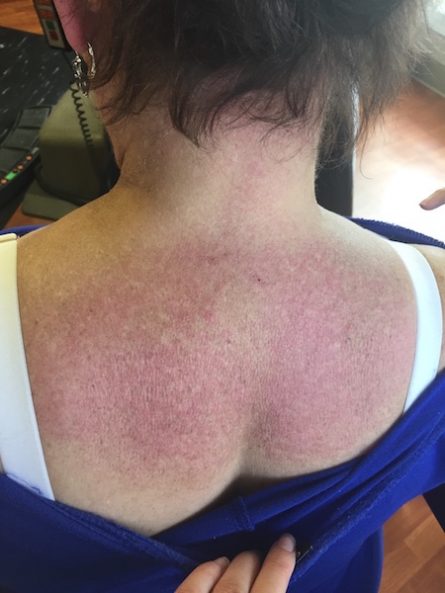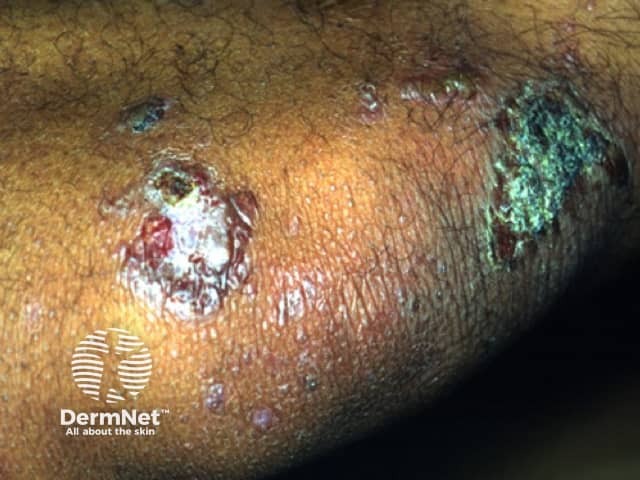CORRECT DIAGNOSIS:
Eruptive Syringoma
DISCUSSION:
These findings were consistent with eruptive syringoma. While the histologic exams are consistent with a syringoma, the clinical presentation of this case is unique. The classic clinical presentation of syringoma is most commonly reported as localized and found in adolescent women in the periorbital region. In a review of 239 cases of syringoma, 88.7% were found to be localized, with 81% located in the periorbital region. This case deviates from this typical presentation in the location and progressive nature of the lesions.
Down syndrome is associated with an increase frequency of syringomas, however the lesions are described as localized periorbital and not as generalized eruptive. In a study of 200 institutionalized patients with Down syndrome, 18.5% demonstrated syringoma, all of which were reported as periorbital.
TREATMENT:
The classic treatment of syringomas consists of electrocoagulation, CO2 laser, retinoids and surgical excision. However, surgical excision, electrocoagulation and CO2 laser were not practical treatment options due to the diffuse involvement of the lesions, and the associated cost of treatments.
We chose to treat our patient with topical tretinoin. To reduce the risk of systemic absorption of the topical retinoid, we started the patient on tretinoin 0.05%. Depending on the tolerance of the medication, we will consider increasing the concentration to 0.1%.
REFERENCES:
Williams K, Shinkai K. Evaluation and management of the patient with multiple syringomas: A systematic review of the literature. Journal of the American Academy of Dermatology. 2016; 74(6):1234-1240.e9.[PMID:26850654]
Resende C, Araújo C, Santos R, Pereira T, Brito C. Late-onset of eruptive syringomas: a diagnostic challenge. Anais brasileiros de dermatologia. ; 90(3 Suppl 1):239-41.[PMID: 26312728]
Bolognia J, Jorizzo J, Schaffer J. Dermatology. 3 ed.: Elsevier; 2012. Chapter 111, Neoplasms of the Skin; p.1841-1842. 2776p.
Hashimoto K, DiBella RJ, Borsuk GM, Lever WF. Eruptive hidradenoma and syringoma. Histological, histochemical, and electron microscopic studies. Archives of dermatology. 1967; 96(5):500-19.[PMID: 4293320]
Friedman SJ, Butler DF. Syringoma presenting as milia. Journal of the American Academy of Dermatology. 1987; 16(2 Pt 1):310-4.[PMID: 3819065]
Ong GC, Lim KS, Chian LY. Eruptive syringoma in a patient with trisomy 21. Singapore medical journal. 2010; 51(2):e46-7.[PMID: 20358144]
Jacquet L, Darier J. Hiydradénomes éruptifs, épithéliomes adénoides des glandes sudoripares ou adénomes sudoripares. Ann Dermatol Syph. 1887 ;8:317-323
Singh S, Tewari R, Gupta S. An unusual case of generalised eruptive syringoma in an adult male. Medical journal, Armed Forces India. 2014; 70(4):389-91.[PMID: 25382918]
James WD, Berger T, Elston D. Andrews’ Diseases of the Skin. 11 ed: Saunders; 2011. Chapter 29, Epidermal Nevi, Neoplasms, and Cysts; p.653-654. 968p.
Elston DM, Ferringer T. Dermatopathology: Expert Consult. 2 ed.: Elsevier; 2013. Chapter 5, Sweat gland neoplasms; p.90-91. 464p.
Gómez MI, Pérez B, Azaña JM, Núñez M, Ledo A. Eruptive syringoma: treatment with topical tretinoin. Dermatology (Basel, Switzerland). 1994; 189(1):105-6.[PMID: 8003779]
BUTTERWORTH T, STREAN LP, BEERMAN H, WOOD MG. SYRINGOMA AND MONGOLISM. Archives of dermatology. 1964; 90:482-7.[PMID: 14200640]
Teixeira M, Ferreira M, Machado S, Alves R, Selores M. Eruptive syringomas. Dermatology online journal. 2005; 11(3):34.[PMID:16409930]




